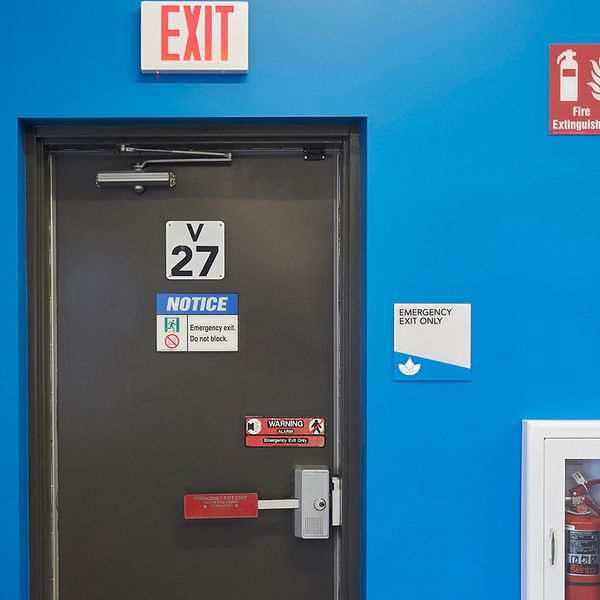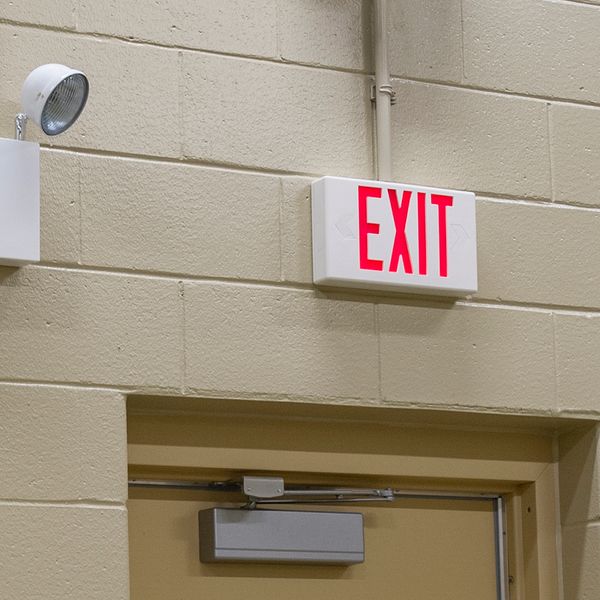The crucial role of clearly marked and illuminated exit signs
Exit signs provide clear and visible guidance during emergencies. In situations where visibility may be limited due to smoke, darkness, or panic, exit signs should be easily spotted, helping people navigate their way to safety. The compliance details surrounding this crucial sign help minimize confusion, reduce evacuation time, and save lives.
Strategically located
Exit signs need to be strategically located in various areas of a building to ensure maximum visibility and effectiveness. Some key locations where exit signs should be placed include:
- Above exit doors: Exit signs should be positioned directly above exit doors to clearly indicate the way out.
- Along exit routes: Exit signs should be placed at regular intervals along exit routes, ensuring they’re visible from any point along the path.
- Changes in direction: If there are changes in direction along an exit route, exit signs should be placed to indicate the correct path to follow.
- Stairwells: Exit signs should be installed at the top and bottom of stairwells to guide individuals toward the nearest exit.
- Corridors and hallways: Exit signs should be placed at intersections, corners, or other locations where individuals may need guidance to find the nearest exit.
- Large open areas: In large open areas, such as auditoriums or warehouses, exit signs should be positioned to provide clear direction towards the nearest exit.
Essentially, you’ll want to place an exit sign wherever it is appropriate along the exit access, which is defined in 1910.34 as “that portion of an exit route that leads to an exit.”
Distinctively illuminated
OSHA states at 1910.37(b)(6) that “each exit sign must be illuminated to a surface value of at least five foot-candles by a reliable light source and be distinctive in color.” There has been confusion over the years about whether exit signs must be a particular color, for instance, red or green.
The general industry regulations don’t call for a particular exit sign color (unless regulated by the construction industry standard at 1926.200, in which case exit signs must be in red letters.) In a September 1972 letter of interpretation, OSHA clarified that any color, or color combination, readily visible or distinctive in appearance is acceptable.
It's important to note that while OSHA regulations don’t mandate a specific color for exit signs, local fire marshals or building inspectors may have preferences or requirements. One should also refer to NFPA 101 Life Safety Code, which suggests that colors providing good contrast, such as red or green letters on a matte white background, are recommended.
Plainly visible
Lettering on exit signs plays a critical role in ensuring the safety and well-being of individuals within a building. It helps to minimize confusion, guide people towards exits, and comply with regulatory requirements. As stated in 1910.37(b)(7), OSHA requires exit signs to be not less than six inches high, with the principal strokes of the letters in the word “EXIT” not less than three-fourths of an inch.
Clear and legible lettering ensures that exit signs can be easily seen and read, even in low-light or emergency situations. This is crucial for guiding people towards the nearest exit and facilitating a safe evacuation. Compliance with these requirements demonstrates a commitment to maintaining a safe and secure environment for occupants and visitors.
Key to remember: Appropriately marked exit routes include exit signs that are strategically located, distinctively illuminated, and plainly visible. This is crucial in providing clear and visible guidance during emergencies.




















































